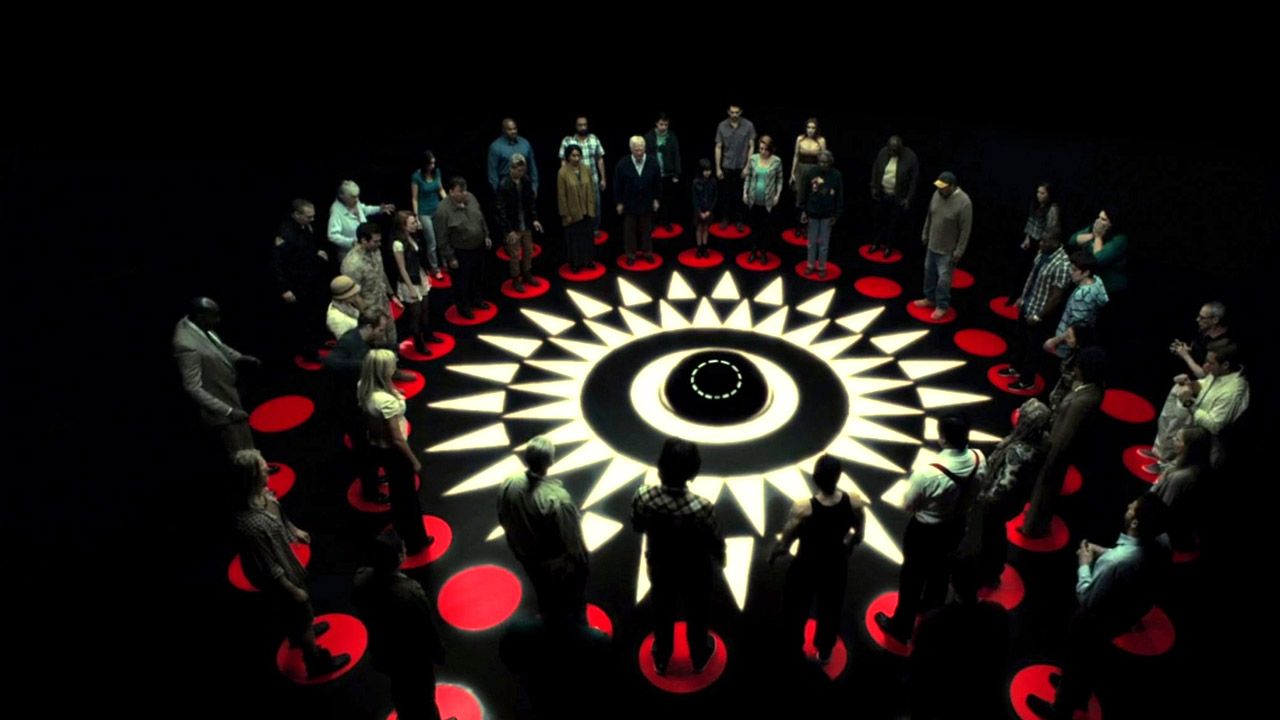In 2020, during the peak phase of the corona pandemic, the dystopia “Der Schacht” dominated the Netflix streaming lists. The bleak futuristic outlook can be assigned to a small but fascinating sci-fi horror subgenre – namely haunting stories that comment on human abysses in a confined space. For example, what in “The Shaft” is a barren prison with a dumbwaiter, in Bong Joon-ho’s “Snowpiercer” is a train circling the earth with strictly segregated social classes.
The genre insider tip “The Circle” by directors and authors Aaron Hann and Mario Miscione can also be attributed to this film genre. It plays in an even narrower space than “Der Schacht” or “Snowpiercer”: It’s a real, claustrophobic room game – a play about how easily people can be pitted against each other.
That’s what “The Circle” is about
50 people wake up in a pitch black room. They were placed on luminous circular plates arranged in a circle. The people’s memories are shattered and they soon discover a laser weapon pointed at them, instantly executing anyone who strays from their plate. But stagnation alone does not save lives.
Then every two minutes a randomly chosen person is executed with a laser. However, this arbitrary mechanism can be worked around: by waving their hands, everyone present can determine who should kill the next laser – the person with the most votes has to believe it – a game even more treacherous than the confrontations in “Squid Game” !
A moral dilemma, oppressively portrayed
“The Circle” uses the futuristic setting of a minimalist, dark room to exaggerate in stylishly simple images how quickly people throw their consciences overboard. Due to the uninterrupted, mercilessly ticking countdown, the initially 50 people at the center of this film have no time to get to know each other. So they are guided by superficiality, peer pressure and prejudice against socio-political views to sentence one person to death every two minutes.
An incredibly clever coup with “The Circle” is that Aaron Hann and Mario Miscione put their audience right in the position of the characters. We don’t have any knowledge advantage over the characters – the movie starts and we’re in the middle of this strange situation. The duo literally encourages their audience to think and philosophize:
You can’t help but wonder what tactics you’d take yourself. Whenever the group puts a few victims up for election, you find yourself figuring out who you would vote for in each round of voting.

But is a speedy, democratic death penalty really more moral than sheer chance? And if you answered the question in the negative: how could you stop the process? And finally, the question arises: why does the whole group get the most callous interpretation of the situation from the small clues? Is there no other way than to choose death row inmates gradually?
Not only does Hann and Miscione rely on this plain, simple, and gripping premise, they also refresh the narrative dynamic over and over again with varied dialogues and alliances that form and fall apart. The author duo constantly confronts the public with unpredictable typifications – Some prisoners correspond 1:1 with the cliché that people have of them according to their self-image, others massively undermine these expectations. And in this very tense stressful situation, the mood barometer keeps changing:
Disputes give way to panicked attempts to negotiate, monologues full of gallows humor turn into tentative attempts at rationalization. and After just over 80 extremely tense, restless film minutes, “The Circle” finds its consistent end, which does without a cheap shock effect. That’s why we can heartily recommend this low-budget insider tip to all genre fans!
Author: Sydney Scheering
Source : Film Starts
I am Dawid Malan, a news reporter for 24 Instant News. I specialize in celebrity and entertainment news, writing stories that capture the attention of readers from all walks of life. My work has been featured in some of the world’s leading publications and I am passionate about delivering quality content to my readers.







